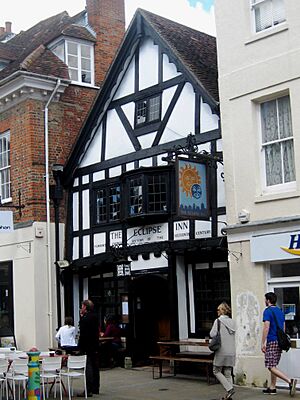Alice Lisle facts for kids
Quick facts for kids
Alice Lisle
|
|
|---|---|
| Born | 1617 |
| Died | September 2, 1685 (aged 67–68) Winchester, England
|
| Burial place | Ellingham, Hampshire, England |
| Nationality | English |
| Spouse(s) | John Lisle |
| Children | 7 |
| Relatives | Thomas Tipping (Brother-in-law) |
Alice Lisle (born September 1617, died 2 September 1685) was an English lady from Hampshire. She is known for her role after the Monmouth Rebellion. She was put on trial for helping people who were hiding from the king's army.
Alice Lisle was the last woman in England to be executed by beheading as a legal punishment.
Contents
Alice Lisle's Family Life
Alice was the daughter of Sir White Beconshaw and Edith Bond. Her family lived at Moyles Court in Ellingham, Hampshire. She had a younger sister named Elizabeth.
Alice married John Lisle (1610-1664). They had seven children together. John Lisle was a lawyer and politician. He supported the Parliament during the English Civil War. He was also involved in the trial of King Charles I of England. After the king's son, Charles II, became king, John Lisle had to leave England. He was later killed in Switzerland in 1664.
What Happened After the Monmouth Rebellion?
The Monmouth Rebellion was a fight against King James II of England. After the king's army won the Battle of Sedgemoor, many people who fought against the king were trying to hide.
On July 20, 1685, Alice Lisle agreed to help two men at her home, Moyles Court. One man was John Hickes, a minister who had been part of Monmouth's army. The other was Richard Nelthorpe, another supporter of Monmouth. The men stayed the night at Moyles Court.
The next morning, both men were arrested. Alice Lisle was then accused of helping people who were considered enemies of the king.
Alice Lisle's Trial
Alice Lisle's trial took place in Winchester. It was led by a judge named Judge Jeffreys. This trial was part of a series of trials known as the "Bloody Assizes."
Alice Lisle said she did not know that John Hickes had done anything more serious than illegal preaching. She also said she knew nothing about Richard Nelthorpe. She insisted she had no sympathy for the rebellion.
Judge Jeffreys was very harsh during the trial. He often reminded the jury about Alice's husband's role in the trial of King Charles I. He told them not to let that influence their decision about Alice, but he kept bringing it up. When the jury seemed unsure, he pressured them to find her guilty.
The jury finally found Alice Lisle guilty after a lot of pressure from the judge. Because the law at the time treated helpers the same as the main offenders in cases of treason, she was sentenced to be burned. However, King James II changed her sentence to beheading because of her social status.
Alice Lisle's Execution
Alice Lisle was publicly executed by an axe in Winchester marketplace on September 2, 1685. She was the last woman in English history to be beheaded as a legal punishment. People who watched said she faced her death bravely.
She is buried in a tomb at St Mary and All Saints Church in Ellingham, Hampshire.
A plaque in Winchester marks the place where Alice Lisle was executed. She spent her last night at The Eclipse Inn, which is near the cathedral.
Alice Lisle's Legacy
Many people have called Alice Lisle's execution a great injustice. Some historians believe she was a victim of the harsh trials that followed the Monmouth Rebellion.
After the Glorious Revolution, when William and Mary became monarchs, one of the first things Parliament did was to reverse Alice Lisle's conviction. They said her trial was unfair and the verdict was forced by Judge Jeffreys' actions.
While Judge Jeffreys followed the strict laws of the time, many believe that King James II should have shown mercy to Alice Lisle.


